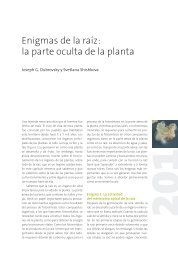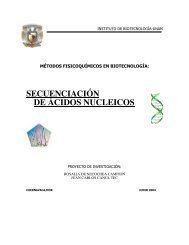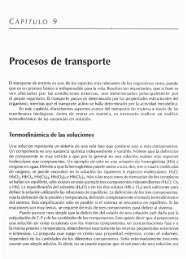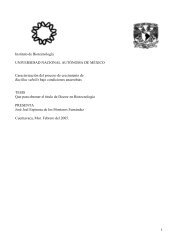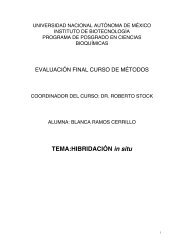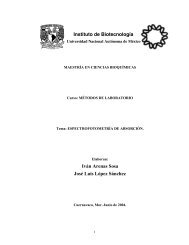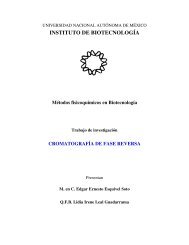Interaction of the virulence protein VirF of Agrobacterium ...
Interaction of the virulence protein VirF of Agrobacterium ...
Interaction of the virulence protein VirF of Agrobacterium ...
You also want an ePaper? Increase the reach of your titles
YUMPU automatically turns print PDFs into web optimized ePapers that Google loves.
258 Brief Communication<br />
<strong>Interaction</strong> <strong>of</strong> <strong>the</strong> <strong>virulence</strong> <strong>protein</strong> <strong>VirF</strong> <strong>of</strong> <strong>Agrobacterium</strong><br />
tumefaciens with plant homologs <strong>of</strong> <strong>the</strong> yeast Skp1 <strong>protein</strong><br />
Barbara Schrammeijer*, Eddy Risseeuw † , Werner Pansegrau*,<br />
Tonny J. G. Regensburg-Tuïnk*, William L. Crosby † and Paul J. J. Hooykaas*<br />
The infection <strong>of</strong> plants by <strong>Agrobacterium</strong> pBI771 [10] and was screened with <strong>the</strong> virF gene cloned<br />
tumefaciens leads to <strong>the</strong> formation <strong>of</strong> crown gall in <strong>the</strong> bait vector pBI770 [10] (pBI770-<strong>VirF</strong>). Saccharo-<br />
tumors due to <strong>the</strong> transfer <strong>of</strong> a nucleo<strong>protein</strong> myces cerevisiae strain YPB2 [11], containing <strong>the</strong> reporter<br />
complex into plant cells that is mediated by <strong>the</strong> genes His3 and lacZ, was used as a host for <strong>the</strong> two-<br />
<strong>virulence</strong> (vir) region–encoded transport system hybrid screen. No activity <strong>of</strong> <strong>the</strong> His3 and lacZ genes was<br />
(reviewed in [1–5]). In addition, A. tumefaciens detected after <strong>the</strong> transformation <strong>of</strong> pBI770-<strong>VirF</strong> alone.<br />
secretes <strong>the</strong> Vir <strong>protein</strong>s, VirE2 and <strong>VirF</strong>, directly into It was also not detected in combination with <strong>the</strong> empty<br />
plant cells via <strong>the</strong> same VirB/VirD4 transport<br />
pBI771 prey vector or with pBI771-<strong>VirF</strong> (data not shown).<br />
system [6], and both assist <strong>the</strong>re in <strong>the</strong> Thus, <strong>VirF</strong> does not by itself activate <strong>the</strong> marker genes<br />
transformation <strong>of</strong> normal cells into tumor cells. The and does not interact with itself in <strong>the</strong> two-hybrid assay.<br />
function <strong>of</strong> <strong>the</strong> 22 kDa <strong>VirF</strong> <strong>protein</strong> is not clear. Western blot analysis with <strong>VirF</strong> polyclonal antibodies con-<br />
Deletion <strong>of</strong> <strong>the</strong> virF gene in A. tumefaciens leads firmed <strong>the</strong> expression <strong>of</strong> <strong>the</strong> Gal4BD-<strong>VirF</strong> and Gal4ADto<br />
diminished <strong>virulence</strong> [7, 8] and can be <strong>VirF</strong> fusion <strong>protein</strong>s in <strong>the</strong> YPB2 yeast strain (data not<br />
complemented by <strong>the</strong> expression <strong>of</strong> <strong>the</strong> virF gene shown). Based on <strong>the</strong>se results, we concluded that <strong>the</strong><br />
in <strong>the</strong> host plant. This finding indicates that <strong>VirF</strong> pBI770-<strong>VirF</strong> plasmid would be suitable for screening a<br />
functions within <strong>the</strong> plant cell [8]. Here, we report cDNA library. Such screens resulted in 16 transformants<br />
that <strong>the</strong> <strong>VirF</strong> <strong>protein</strong> is <strong>the</strong> first prokaryotic <strong>protein</strong> expressing both reporter genes. From each transformant<br />
with an F box by which it can interact with plant <strong>the</strong> cDNA plasmid was rescued and fur<strong>the</strong>r characterized.<br />
homologs <strong>of</strong> <strong>the</strong> yeast Skp1 <strong>protein</strong>. The presence Sequence analysis revealed that 14 <strong>of</strong> <strong>the</strong> 16 contained<br />
<strong>of</strong> <strong>the</strong> F box turned out to be essential for <strong>the</strong> <strong>the</strong> same gene. One <strong>of</strong> <strong>the</strong>se and <strong>the</strong> remaining two clones<br />
biological function <strong>of</strong> <strong>VirF</strong>. F box <strong>protein</strong>s and Skp1p that had unique genes were used again in <strong>the</strong> two-hybrid<br />
are both subunits <strong>of</strong> a class <strong>of</strong> E3 ubiquitin ligases assay, which confirmed <strong>the</strong>ir specific interaction with <strong>VirF</strong><br />
referred to as SCF complexes. Thus, <strong>VirF</strong> may be<br />
involved in <strong>the</strong> targeted proteolysis <strong>of</strong> specific host<br />
(see below).<br />
<strong>protein</strong>s in early stages <strong>of</strong> <strong>the</strong> transformation<br />
process.<br />
The 14 cDNA clones, which represented an identical<br />
open reading frame (ORF), were found to encode <strong>the</strong> 18<br />
* Institute <strong>of</strong> Molecular Plant Sciences, Clusius Laboratory, Leiden<br />
University, 2333 AL Leiden, The Ne<strong>the</strong>rlands.<br />
kDa ASK1 (Arabidopsis Skp1–like) <strong>protein</strong>. The o<strong>the</strong>r<br />
two cDNA clones encoded <strong>the</strong> related 19 kDa ASK2<br />
†Plant Biotechnology<br />
Institute, NRC Canada, Saskatoon, Saskatchewan S7N 0W9, Canada. <strong>protein</strong> and a new 19 kDa member (ASK10) <strong>of</strong> <strong>the</strong> ASK<br />
family, which consists <strong>of</strong> nine previously identified genes.<br />
Correspondence: Paul Hooykaas<br />
E-mail: hooykaas@rulbim.leidenuniv.nl<br />
Protein alignment showed that <strong>the</strong> ASK10 <strong>protein</strong> was<br />
more distant from <strong>the</strong> o<strong>the</strong>r two; it had only 54% and<br />
Received: 13 November 2000<br />
51% identity with ASK1 and ASK2, respectively (Figure<br />
Revised: 28 December 2000 1). To confirm that <strong>the</strong> interactions detected by <strong>the</strong> yeast<br />
Accepted: 28 December 2000 two-hybrid system were genuine and direct, we mixed<br />
Published: 20 February 2001<br />
purified <strong>VirF</strong> <strong>protein</strong> with a glutathione Sepharose 4B<br />
matrix bound by ei<strong>the</strong>r glutathione S-transferase (GST)<br />
Current Biology 2001, 11:258–262<br />
or by GST-ASK1 or GST-ASK2 fusion <strong>protein</strong>. After thor-<br />
0960-9822/01/$ – see front matter ough washing, <strong>the</strong> <strong>protein</strong>s bound to <strong>the</strong> matrix were<br />
© 2001 Elsevier Science Ltd. All rights reserved. recovered. Immunoblotting showed a clear binding <strong>of</strong><br />
<strong>VirF</strong> with <strong>the</strong> matrix associated with ei<strong>the</strong>r <strong>of</strong> <strong>the</strong> GST-<br />
ASK fusion <strong>protein</strong>s. Some residual binding was found<br />
Results and discussion<br />
To learn more about <strong>the</strong> in planta function <strong>of</strong> <strong>VirF</strong>, we<br />
used <strong>the</strong> yeast two-hybrid system to search for plant inter-<br />
action partners. An Arabidopsis thaliana cDNA library, constructed<br />
from above-ground parts <strong>of</strong> 2-week-old seedlings<br />
for <strong>VirF</strong> when GST alone bound <strong>the</strong> matrix (Figure 2).<br />
These biochemical experiments thus confirm <strong>the</strong> data<br />
from <strong>the</strong> two-hybrid experiments and suggest that <strong>the</strong>re<br />
is a direct interaction between <strong>VirF</strong> and <strong>the</strong> ASK <strong>protein</strong>s.<br />
and mature flowering plants <strong>of</strong> <strong>the</strong> Arabidopsis thaliana Recently, it was found that <strong>the</strong> yeast Skp1 <strong>protein</strong> and<br />
ecotype Columbia [9], was made in <strong>the</strong> two-hybrid vector<br />
its animal and plant homologs, such as <strong>the</strong> A. thaliana
Figure 1<br />
Alignment <strong>of</strong> <strong>the</strong> deduced amino acid<br />
sequence for ASK1, ASK2, and ASK10. The<br />
GenBank accession numbers are,<br />
respectively, ATU97020, ATU97021, and<br />
AF132729. Similar or identical amino acids<br />
are placed in a box; gaps in <strong>the</strong> alignment<br />
are indicated by dots.<br />
Brief Communication 259<br />
ASK <strong>protein</strong>s, are subunits <strong>of</strong> a class <strong>of</strong> E3 ubiquitin used <strong>the</strong> mutant <strong>VirF</strong> plasmids in two-hybrid assays with<br />
ligases called SCF (Skp1-Cdc53-F box <strong>protein</strong>) com- <strong>the</strong> ASK <strong>protein</strong>s. In such assays no interaction with ASK1,<br />
plexes. These complexes target specific <strong>protein</strong>s for prote- ASK2, or ASK10 was any longer observed, nei<strong>the</strong>r for <strong>the</strong><br />
olysis and thus play an important regulatory role in pro- <strong>VirF</strong>�F-box nor for <strong>the</strong> <strong>VirF</strong>(LP→AA) <strong>protein</strong>, in contrast<br />
cesses such as <strong>the</strong> cell cycle [12–15]. SCF complexes with <strong>the</strong> results for <strong>the</strong> full-length <strong>VirF</strong> <strong>protein</strong> (Figure<br />
consist <strong>of</strong> a scaffold <strong>protein</strong>, Cdc53p or Cullin, to which 3a,b). These results indicate that <strong>the</strong> binding to ASK1,<br />
is bound Cdc34p, which is an ubiquitin-conjugating en- ASK2, and ASK10 is mediated by <strong>the</strong> F box present in<br />
zyme; <strong>the</strong> Rbx1 <strong>protein</strong>, which assists in <strong>the</strong> recruitment<br />
and activation <strong>of</strong> Cdc34p; and Skp1p. This latter <strong>protein</strong><br />
<strong>VirF</strong>.<br />
may in turn recruit a variety <strong>of</strong> so-called F box <strong>protein</strong>s<br />
by binding directly to <strong>the</strong>ir F box. The F box <strong>protein</strong>s<br />
act as receptors, which attract specific <strong>protein</strong>s to <strong>the</strong> SCF<br />
complex for ubiquitination and subsequent proteolysis.<br />
The binding <strong>of</strong> <strong>VirF</strong> to <strong>the</strong> ASK <strong>protein</strong>s suggested that<br />
<strong>VirF</strong> may also contain an F box motif. Comparison <strong>of</strong><br />
<strong>VirF</strong> with F box–containing <strong>protein</strong>s from various species<br />
[12] indeed revealed <strong>the</strong> presence <strong>of</strong> <strong>the</strong> conserved leucine<br />
and proline residues (amino acids 26, 27, and 38) in<br />
<strong>VirF</strong>. Additionally, <strong>the</strong> presence <strong>of</strong> an F box in <strong>VirF</strong> was<br />
confirmed by <strong>the</strong> Pr<strong>of</strong>ileScan program for amino acid positions<br />
20 to 42: KTELLNLPDHVLTEVAKRLATNN.<br />
To find out whe<strong>the</strong>r <strong>the</strong> presence <strong>of</strong> an F box is essential<br />
for <strong>the</strong> functioning <strong>of</strong> <strong>VirF</strong> in tumorigenesis, we intro-<br />
duced <strong>the</strong> <strong>VirF</strong>(LP→AA) mutant allele into an Agrobacter-<br />
ium virF deletion mutant. Virulence assays showed that <strong>the</strong><br />
<strong>Agrobacterium</strong> strains producing <strong>the</strong> mutant form <strong>of</strong> <strong>VirF</strong><br />
instead <strong>of</strong> wild-type <strong>VirF</strong> were attenuated in <strong>virulence</strong><br />
on Nicotiana glauca plants, as were virF deletion mutants.<br />
Figure 3c shows an example <strong>of</strong> a stem infection. Thus,<br />
<strong>the</strong> presence <strong>of</strong> a functional F box seems essential for <strong>the</strong><br />
biological function <strong>of</strong> <strong>VirF</strong>. The presence <strong>of</strong> a functional<br />
F box in <strong>the</strong> A. tumefaciens <strong>VirF</strong> <strong>protein</strong> is surprising. So<br />
far F box <strong>protein</strong>s have only been found in eukaryotic<br />
organisms such as yeast, humans, plants, and fungi as well<br />
We created an N-terminal deletion, including <strong>the</strong> deletion as in human viruses [12–15], but not in prokaryotes. <strong>VirF</strong><br />
<strong>of</strong> <strong>the</strong> F box, to confirm that <strong>VirF</strong> binds ASK1, ASK2, is <strong>the</strong> first F box <strong>protein</strong> identified in bacteria. The finding<br />
and ASK10 via its F box. For <strong>the</strong> same reason, we replaced <strong>of</strong> a gene for an F box <strong>protein</strong> on <strong>the</strong> Ti plasmid <strong>of</strong> A.<br />
<strong>the</strong> two most-conserved amino acids <strong>of</strong> <strong>the</strong> F box, leucine tumefaciens underscores <strong>the</strong> remarkable gene content <strong>of</strong><br />
26 and proline 27, by alanine. Previous studies have shown this genetic element, which includes not only typically<br />
that mutation <strong>of</strong> <strong>the</strong> conserved leucine and proline resi- eukaryotic genes with eukaryotic expression signals but<br />
dues in <strong>the</strong> F box <strong>protein</strong> Cdc4p results in decreased also prokaryotic genes coding for <strong>protein</strong>s with eukaryotic<br />
binding <strong>of</strong> Skp1p [12] and that mutation <strong>of</strong> <strong>the</strong> conserved features such as <strong>the</strong> nuclear localization sequence (VirD2,<br />
leucine residue in <strong>the</strong> F box <strong>protein</strong> SCON2 leads to a VirE2) and <strong>the</strong> F box (<strong>VirF</strong>). Although no direct evidence<br />
loss <strong>of</strong> function [16]. The YPB2 yeast strain was trans- has been obtained so far, it seems likely that some <strong>of</strong> this<br />
formed with ei<strong>the</strong>r pBI770-<strong>VirF</strong>�F-box or pBI770-Virgenetic material was introduced into this bacterium by<br />
F(LP→AA) alone (data not shown) or in combination with<br />
<strong>the</strong> empty vector pBI771 (Figure 3). As expected, <strong>the</strong><br />
horizontal gene transfer from an eukaryotic organism.<br />
Gal4BD-<strong>VirF</strong>�F-box and Gal4BD-<strong>VirF</strong>(LP→AA) fusion Proteins with similarity to <strong>the</strong> <strong>VirF</strong> <strong>protein</strong> described<br />
<strong>protein</strong>s could not activate transcription <strong>of</strong> <strong>the</strong> reporter above are encoded by o<strong>the</strong>r types <strong>of</strong> Ti plasmids as well<br />
genes in yeast, as <strong>the</strong> lack <strong>of</strong> lacZ or His3 expression as by <strong>the</strong> Ri plasmid <strong>of</strong> <strong>Agrobacterium</strong> rhizogenes ([17], Genindicated.<br />
Western blot analysis with <strong>VirF</strong> polyclonal anti- Bank accession numbers AF034769 and AP002086). A<br />
bodies showed <strong>the</strong> expression <strong>of</strong> <strong>the</strong> Gal4BD-<strong>VirF</strong>�F- comparison <strong>of</strong> <strong>the</strong> F box regions revealed <strong>the</strong> presence<br />
box and Gal4BD-<strong>VirF</strong>(LP→AA) fusion <strong>protein</strong>s in <strong>the</strong> <strong>of</strong> <strong>the</strong> conserved leucine and proline residues in <strong>the</strong> <strong>VirF</strong><br />
YPB2 yeast strain (data not shown). As <strong>the</strong> control experi- homologs encoded by <strong>the</strong> A. vitis Ti plasmid and <strong>the</strong> Ri<br />
ments did not show unexpected results, we subsequently<br />
plasmid. We have shown previously that <strong>the</strong> <strong>VirF</strong> homolog
260 Current Biology Vol 11 No 4<br />
Figure 2 Figure 3<br />
The F box <strong>of</strong> <strong>VirF</strong> is essential for <strong>VirF</strong> to bind to <strong>the</strong> ASK <strong>protein</strong>s and<br />
for its biological function. (a) �-galactosidase activity on a filterlifted<br />
yeast streak; (b) Growth on medium lacking histidine (�5 mM<br />
3-amino-1�, 2�, 4�-triazole). AD indicates <strong>the</strong> Gal4 activation domain,<br />
BD indicates <strong>the</strong> Gal4 binding domain. (c) Tumorigenicity on N. glauca<br />
by (1) <strong>the</strong> control with wild-type virF; (2) <strong>the</strong> virF deletion mutant;<br />
(3) <strong>the</strong> virF deletion mutant with <strong>the</strong> virF (LP→AA) allele in trans and<br />
(4) in cis.<br />
from <strong>the</strong> Ti plasmid <strong>of</strong> A. vitis can complement A. tumefaciens<br />
virF deletion mutants for tumor formation on Nicotiana<br />
glauca [17]. Also, we have observed “extracellular”<br />
complementation for tumor formation on N. glauca <strong>of</strong> a<br />
Specific binding <strong>of</strong> <strong>VirF</strong> to <strong>the</strong> ASK <strong>protein</strong>s. The <strong>VirF</strong> <strong>protein</strong> was virF deletion mutant by coinfection with an <strong>Agrobacterium</strong><br />
produced in E. coli strain SCS1 and was purified (99.8% pure) by strain carrying <strong>the</strong> Ri plasmid <strong>of</strong> A. rhizogenes (our unpub-<br />
HiTrapQ chromatography, hydroxyapatite chromatography and<br />
Superose gel filtration. The ASK1 and ASK2 genes from A. thaliana lished results). These results can be explained by <strong>the</strong><br />
were cloned into <strong>the</strong> GST-fusion vector pGEX-KG (Pharmacia presence <strong>of</strong> a gene encoding a functional <strong>VirF</strong> homolog<br />
Biotech). The GST-ASK fusion <strong>protein</strong>s and GST were produced on <strong>the</strong> A. vitis Ti plasmid and <strong>the</strong> Ri plasmid.<br />
in E. coli strain SCS1 and bound to a Glutathione Sepharose 4B<br />
matrix. These matrices, loaded with 750 ng GST or GST-ASK, were<br />
<strong>the</strong>n incubated with 750 ng <strong>VirF</strong>. We removed unbound <strong>VirF</strong> by The virF mutant was initially identified as a mutant with a<br />
washing <strong>the</strong> matrix three times with buffer. We solubilized <strong>protein</strong>s<br />
associated with <strong>the</strong> matrix in 65 �l total volume by boiling <strong>the</strong>m, and<br />
we <strong>the</strong>n separated 15 �l <strong>protein</strong> sample by SDS-PAGE and incubated with <strong>VirF</strong>, and <strong>the</strong>n recovered from <strong>the</strong> matrix; (c) Lane 1,<br />
identified (a,b) ASK or (c) <strong>VirF</strong> after Western blotting. The lanes purified <strong>VirF</strong> <strong>protein</strong>; Lane 2, material recovered from <strong>the</strong> glutathione<br />
correspond to <strong>the</strong> following <strong>protein</strong>s: (a,b) Lane 1, Lysate <strong>of</strong> matrix in <strong>the</strong> absence <strong>of</strong> any GST <strong>protein</strong>; Lane 3, <strong>VirF</strong> recovered from<br />
E. coli with <strong>the</strong> GST-ASK <strong>protein</strong>; Lane 2, GST-ASK <strong>protein</strong> <strong>the</strong> matrix associated with GST-ASK1; Lane 4, <strong>VirF</strong> recovered from <strong>the</strong><br />
that was bound to and <strong>the</strong>n recovered from <strong>the</strong> glutathione matrix associated with GST-ASK2; Lane 5, material recovered from<br />
matrix; Lane 3, GST-ASK <strong>protein</strong> that was bound to <strong>the</strong> matrix, <strong>the</strong> matrix associated with GST alone.
Brief Communication 261<br />
mutation in <strong>the</strong> octopine type Ti plasmid with diminished been identified. This substrate must be ano<strong>the</strong>r direct<br />
<strong>virulence</strong> on tomatoes [18]. Later, Nicotiana glauca was interaction partner <strong>of</strong> <strong>VirF</strong>. However, this has so far not<br />
found to be <strong>the</strong> preferred host for studying <strong>the</strong> effects <strong>of</strong> been identified in two-hybrid screens. The reason may<br />
virF mutations [7]. On o<strong>the</strong>r hosts, <strong>the</strong> role <strong>of</strong> virF in be that <strong>the</strong> substrate needs to be modified in order for<br />
transformation only becomes clear upon <strong>the</strong> mutation <strong>of</strong> <strong>the</strong> interaction to take place. It is known that many targets<br />
a second gene, called virE3 (our unpublished results). must first be phosphorylated and can subsequently inter-<br />
The mutation <strong>of</strong> virE3 by itself has no or only mild negative<br />
effects on <strong>the</strong> <strong>virulence</strong> <strong>of</strong> <strong>Agrobacterium</strong>, but subse-<br />
act with <strong>the</strong> SCF complex [12–15, 20].<br />
quent mutation <strong>of</strong> virF leads to strongly diminished <strong>virulence</strong>.<br />
Apparently, <strong>the</strong>re seems to be some redundancy<br />
in <strong>the</strong> functions mediated by <strong>the</strong> <strong>VirF</strong> and VirE3 <strong>protein</strong>s.<br />
The VirE3 <strong>protein</strong>, like VirE2 and <strong>VirF</strong>, contains <strong>the</strong><br />
amino acid motif Arg-Pro-Arg at <strong>the</strong> C terminus. This<br />
motif forms part <strong>of</strong> <strong>the</strong> transport signal, which is recognized<br />
by <strong>the</strong> VirB/VirD4 channel, which mediates <strong>protein</strong><br />
The precise mechanism whereby <strong>VirF</strong> affects tumorigen-<br />
esis awaits fur<strong>the</strong>r study, including <strong>the</strong> identification <strong>of</strong><br />
<strong>the</strong> <strong>protein</strong>s, which are targeted by <strong>VirF</strong> for proteolysis.<br />
But <strong>the</strong> results obtained so far once more illustrate <strong>the</strong><br />
sophistication <strong>of</strong> plant tumor induction by <strong>the</strong> bacterium<br />
A. tumefaciens.<br />
secretion directly from <strong>Agrobacterium</strong> into <strong>the</strong> plant cell Acknowledgements<br />
[6]. This suggests that VirE3 is also secreted by A. tumefa- We thank Susanne E. Kohalmi for kindly providing <strong>the</strong> Arabidopsis thaliana<br />
ciens into plant cells via <strong>the</strong> VirB/VirD4 transport system,<br />
as has been shown for VirE2 and <strong>VirF</strong> [6]. There is no<br />
o<strong>the</strong>r similarity between <strong>the</strong> <strong>VirF</strong> and VirE3 <strong>protein</strong>s.<br />
cDNA library, <strong>the</strong> pBI770 and pBI771 plasmids, <strong>the</strong> YPB2 strain, and <strong>the</strong><br />
HisASK1 antibodies. We thank Jan Schouten for kindly providing plasmids<br />
with <strong>the</strong> A.thaliana ASK genes. The work <strong>of</strong> Werner Pansegrau was financed<br />
by EU-FP5 research training grant ERB4001GT963065 <strong>of</strong> <strong>the</strong> European<br />
Also, in contrast to <strong>VirF</strong>, VirE3 contains putative nuclear<br />
localization signal sequences, which suggest a function<br />
Community. This work was supported by <strong>the</strong> Ne<strong>the</strong>rlands Foundation for<br />
Chemical Research (SON) with financial aid from <strong>the</strong> Ne<strong>the</strong>rlands Organiza-<br />
tion for Scientific Research (NWO). Thanks are due to Drs. L. Banta, R.<br />
for VirE3 in <strong>the</strong> plant cell nucleus. VirE3 may thus compensate<br />
for <strong>the</strong> absence <strong>of</strong> <strong>VirF</strong> by an entirely different<br />
Offringa, and E.J. van der Zaal for critical reading <strong>of</strong> <strong>the</strong> manuscript.<br />
molecular mechanism <strong>of</strong> action. References<br />
1. Kado CI: Molecular mechanisms <strong>of</strong> crown gall tumorigenesis.<br />
Critical Reviews in Plant Sciences 1991, 10:1-32.<br />
In view <strong>of</strong> <strong>the</strong> strong conservation <strong>of</strong> <strong>the</strong> Skp1 <strong>protein</strong>s,<br />
we predict that Skp1 <strong>protein</strong>s <strong>of</strong> o<strong>the</strong>r plant species such<br />
as N. glauca will interact with <strong>VirF</strong> similarly to <strong>the</strong> way<br />
2.<br />
3.<br />
Hooykaas PJJ, Beijersbergen AGM: The <strong>virulence</strong> system <strong>of</strong><br />
<strong>Agrobacterium</strong> tumefaciens. Annu Rev Phytopathol 1994,<br />
32:157-179.<br />
Zupan J, Zambryski P: The <strong>Agrobacterium</strong> tumefaciens DNA<br />
transfer complex. Critical Reviews in Plant Sciences 1997,<br />
in which A. thaliana Skp1 homologs do. F box <strong>protein</strong>s 16:279-295.<br />
form part <strong>of</strong> SCF complex ubiquitin ligases and determine<br />
which substrate <strong>protein</strong>s will be targeted for ubiquitination<br />
and subsequent proteolysis by <strong>the</strong> proteasome. Such<br />
4.<br />
5.<br />
Winans SC: Two-way chemical signaling in <strong>Agrobacterium</strong>-<br />
plant interactions. Microbiol Rev 1992, 56:12-31.<br />
Christie PJ: <strong>Agrobacterium</strong> tumefaciens T-complex transport<br />
apparatus: a paradigm for a new family <strong>of</strong> multifunctional<br />
substrates include promoters and inhibitors <strong>of</strong> <strong>the</strong> cell<br />
cycle as well as signal transduction components. F box<br />
6.<br />
transporters in eubacteria. J Bacteriol 1997, 179:3085-3094.<br />
Vergunst AC, Schrammeijer B, den Dulk-Ras A, de Vlaam CM,<br />
Regensburg-Tuïnk TJ, Hooykaas PJ: VirB/D4-dependent<br />
<strong>protein</strong>s thus play an important regulatory role in <strong>the</strong> <strong>protein</strong> translocation from <strong>Agrobacterium</strong> into plant cells.<br />
control <strong>of</strong> cell division and differentiation and, consequently,<br />
in <strong>the</strong> growth and development <strong>of</strong> eukaryotic<br />
7.<br />
Science 2000, 290:979-982.<br />
Melchers LS, Maroney MJ, den Dulk-Ras A, Thompson DV, van Vuuren<br />
HA, Schilperoort RA, Hooykaas PJ: Octopine and nopaline<br />
organisms. It may be that <strong>VirF</strong>, as part <strong>of</strong> an SCF complex,<br />
likewise affects <strong>the</strong> cell cycle. For instance, maintaining<br />
strains <strong>of</strong> <strong>Agrobacterium</strong> tumefaciens differ in <strong>virulence</strong>;<br />
molecular characterization <strong>of</strong> <strong>the</strong> virF locus. Plant Mol Biol<br />
1990, 14:249-259.<br />
cells for an extended period <strong>of</strong> time in <strong>the</strong> S-phase may 8. Regensburg-Tuïnk AJ, Hooykaas PJ: Transgenic N. glauca plants<br />
expressing bacterial <strong>virulence</strong> gene virF are converted into<br />
facilitate T-DNA integration. In <strong>the</strong> plant cell, <strong>VirF</strong> seems hosts for nopaline strains <strong>of</strong> A. tumefaciens. Nature 1993,<br />
to play a role specifically during <strong>the</strong> infection by Agrobac- 363:69-71.<br />
terium since <strong>VirF</strong> transgenic plants show no aberrant phe-<br />
9. Kohalmi SE, Nowak J, Crosby WL: A practical guide to using <strong>the</strong><br />
notype (data not shown). The latter may be due to <strong>the</strong><br />
inherent instability <strong>of</strong> F box <strong>protein</strong>s, which are targeted<br />
yeast 2-hybrid system. InDifferentially Expressed Genes in<br />
Plants: A Bench Manual. Edited by Harper G and Hansen E. London:<br />
Taylor & Francis; 1997:63-82.<br />
for destruction by ubiquitination during <strong>the</strong>ir transient<br />
presence in <strong>the</strong> SCF complex [19]. In recent transport<br />
10. Kohalmi SE, Reader LJV, Samach A, Nowak J, Haughn GW, Crosby<br />
WL: Identification and characterization <strong>of</strong> <strong>protein</strong><br />
interactions using <strong>the</strong> yeast 2-hybrid system. InPlant Molecular<br />
experiments, <strong>the</strong> delivery <strong>of</strong> a NLS::Cre::<strong>VirF</strong> fusion pro- Biology Manual M1. Edited by Gelvin SB and Schilperoort RA.<br />
Dordrecht, The Ne<strong>the</strong>rlands: Kluwer Academic Publishers;<br />
tein into plant cells seemed to occur much more efficiently<br />
after deletion <strong>of</strong> <strong>the</strong> F box [6]. This may be due not so<br />
1998:1-30.<br />
much to enhanced transport as to enhanced stability after <strong>protein</strong> interactions. Nature 1989, 340:245-246.<br />
deletion <strong>of</strong> <strong>the</strong> F box. A full understanding <strong>of</strong> <strong>the</strong> function SKP1 connects cell cycle regulators to <strong>the</strong> ubiquitin<br />
<strong>of</strong> <strong>VirF</strong> will not be possible until <strong>the</strong> <strong>the</strong> participation <strong>of</strong><br />
<strong>VirF</strong> in an SCF complex is experimentally confirmed and<br />
<strong>the</strong> substrate targeted for proteolysis by <strong>the</strong> complex has<br />
13.<br />
1996, 86:263-274.<br />
Skowyra D, Craig KL, Tyers M, Elledge SJ, Harper JW: F-box<br />
<strong>protein</strong>s are receptors that recruit phosphorylated<br />
11. Fields S, Song O: A novel genetic system to detect <strong>protein</strong>-<br />
12. Bai C, Sen P, H<strong>of</strong>mann K, Ma L, Goebl M, Harper JW, Elledge SJ:<br />
proteolysis machinery through a novel motif, <strong>the</strong> F-box. Cell
262 Current Biology Vol 11 No 4<br />
substrates to <strong>the</strong> SCF ubiquitin-ligase complex. Cell 1997,<br />
91:209-219.<br />
14. Feldman RM, Correll CC, Kaplan KB, Deshaies RJ: A complex <strong>of</strong><br />
Cdc4p, Skp1p, and Cdc53p/cullin catalyzes ubiquitination<br />
<strong>of</strong> <strong>the</strong> phosphorylated CDK inhibitor Sic1p. Cell 1997,<br />
91:221-230.<br />
15. Koepp DM, Harper JW, Elledge SJ: How <strong>the</strong> cyclin became a<br />
cyclin: regulated proteolysis in <strong>the</strong> cell cycle. Cell 1999,<br />
97:431-434.<br />
16. Kumar A, Paietta JV: An additional role for <strong>the</strong> F-box motif:<br />
gene regulation within <strong>the</strong> Neurospora crassa sulfur<br />
control network. Proc Natl Acad Sci USA 1998, 95:2417-2422.<br />
17. Schrammeijer B, Hemelaar J, Hooykaas PJ: The presence and<br />
characterization <strong>of</strong> a virF gene on <strong>Agrobacterium</strong> vitis Ti<br />
plasmids. Mol Plant Microbe Interact 1998, 11:429-433.<br />
18. Hooykaas PJJ, H<strong>of</strong>ker M, den Dulk-Ras H, Schilperoort RA: A<br />
comparison <strong>of</strong> <strong>virulence</strong> determinants in an octopine Ti<br />
plasmid, a nopaline Ti plasmid, and an Ri plasmid by<br />
complementation analysis <strong>of</strong> <strong>Agrobacterium</strong> tumefaciens<br />
mutants. Plasmid 1984, 11:195-205.<br />
19. Galan JM, Peter M: Ubiquitin-dependent degradation <strong>of</strong><br />
multiple F-box <strong>protein</strong>s by an autocatalytic mechanism.<br />
Proc Natl Acad Sci USA 1999, 96:9124-9129.<br />
20. Patton EE, Willems AR, Tyers M: Combinatorial control in<br />
ubiquitin-dependent proteolysis: don’t Skp <strong>the</strong> F-box<br />
hypo<strong>the</strong>sis. Trends Genet 1998, 14:236-243.




